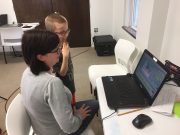The pencil – a great invention that has served humanity well for hundreds of years. Yes—it still is a very helpful tool, but it’s not the best tool for every situation. Nobody would argue that we should cling desperately to the pencil as our primary tool for communication in today’s world. Why is it, then, that educators cling to a narrow range of communication tools in the curricula they offer our students?
The foremost domain for communication in today’s society is the Internet. A pencil doesn’t do anyone much good in that space. What does get attention and facilitate understanding are great ideas or stories supported by images, videos, interesting text, and appealing sounds and music—multimedia. Progressive educators are making sure that their students are developing effective multimedia communication skills. For example, Todd Taylor, Professor of English and Director of the First Year Writing Program at the University of North Carolina-Chapel Hill adds these format requirements for their research papers: they must produce the research in the form of a magazine article, a documentary film, a podcast, a website, and a mobile app. He argues that this work is meant to be shared, but the term paper format does not invite sharing.
That’s the nature of communication in the 21st Century. We communicate on an enlarged stage—often a global stage. Our content moves through vast digital networks and finds its way not only to those we target but also to those who might find our ideas of interest. Those audiences embrace multimedia communication. Words aren’t always enough to get our ideas across. Those who can effectively choose an image, add a video or produce a pleasing soundtrack can break through the prevailing barriers of indifference or confusion of an Internet audience. Words flying solo may not make the landing you expect for them.
I got my job as an editor at Hallmark Cards because I was good with words. But when my duties shifted to those as a training manager for the Creative Division, my visually-oriented audiences of illustrators, photographers, sculptors and calligraphers needed more. They needed learning solutions that embraced what they could see, hear and feel. I quickly realized that their learning needed to embrace multimedia. I believe that today’s Internet-connected society wants the same. They want to experience ideas and stories through images, videos, sounds, words and more.
That’s what our schools need to offer in order to prepare students to be effective communicators in our Internet-connected society.
digiSTORY KC is working with TEACH Multimedia to help schools teach multimedia communication skills. That’s why we developed our new stop-motion animation curriculum for grades 4 through 8. The goal is not to make them great stop-motion animators. That’s just the attraction factor for students who will be developing lots of multimedia skills along the way: image capture and manipulation, video production and editing, audio capture and editing, animation, design composition, camera angles and much more. By using these skills in their communication, students can inform and influence others more effectively than those who only experience the standard school communication curriculum.
Discover how our new 20-lesson online curriculum for stop-motion animation can improve students’ multimedia communication skills. Let them keep their pencils, but help them greatly expand their communication toolkit!







